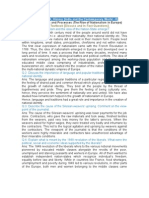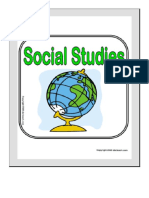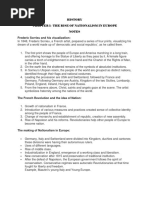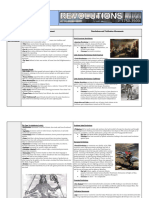Section 1: Name: Maria Cristina S. Importante Yr. & Section: Bsed 4 Social Studies
Section 1: Name: Maria Cristina S. Importante Yr. & Section: Bsed 4 Social Studies
Uploaded by
maria cristinaCopyright:
Available Formats
Section 1: Name: Maria Cristina S. Importante Yr. & Section: Bsed 4 Social Studies
Section 1: Name: Maria Cristina S. Importante Yr. & Section: Bsed 4 Social Studies
Uploaded by
maria cristinaOriginal Title
Copyright
Available Formats
Share this document
Did you find this document useful?
Is this content inappropriate?
Copyright:
Available Formats
Section 1: Name: Maria Cristina S. Importante Yr. & Section: Bsed 4 Social Studies
Section 1: Name: Maria Cristina S. Importante Yr. & Section: Bsed 4 Social Studies
Uploaded by
maria cristinaCopyright:
Available Formats
Name: MARIA CRISTINA S. IMPORTANTE Yr.
& Section: BSED 4 SOCIAL STUDIES
CHAPTER 3
Nationalist Revolutions Sweep the West, 1789-1900
Section 1
Latin American Peoples Win Independence
Recognizing Facts and Details. Fill out the chart below to help you better understand why
and how Latin Americans fought colonial rule.
Independence for Haiti
Reasons
1. Why did slaves in the French Colony of Saint Domingue revolt?
White masters used brutal methods to terrorize slaves. outnumbered
masters. Poor, hungry, and desperate.
Strategy
2. What events led up to General Dessalines declaration of independence for Haiti?
Toussaint removed from power, imprisoned.
South American Wars of Independence
Reasons
3. How did events in Europe lead to revolution in the Spanish colonies
Bolivar lead a march through Andes, guerilla tactics (surprise attacks)
Strategy
4. What tactics did Jose de San Martin and Simon Bolivar use to defeat Spanish
forces in South America?
Bolivar marched through the Andes to Colombia and caught Spanish
off guard. de San Martin marched through the Andes to Chile and
defeats the Spanish with Bernardo O'Higgins
End of Spanish Rule in Mexico
Reasons
5. What is the significance of the grito de Dolores?
Is a call for the rebellion against the Spanish.
Strategy
6. What role did Indians, mestizos, and creoles play in Mexico’s independence from
Spain?
Mestizos started war, Creoles joined later
Section 2
Europe Faces Revolutions
Define the following terms.
For each term or name, write a sentence explaining its significance.
Conservatives Usually wealthy property owners and nobility.
They argued for protecting the traditional
monarchies of Europe.
Liberals Mostly middle-class business leaders and
merchants.
They wanted to give more power to elected
parliaments, but only the educated and the
landowners would vote.
Radicals Favored drastic change to extend democracy to
all people.
They believed that governments should practice
the ideals of the French Revolution—liberty,
equality, and brotherhood.
Nationalism Is the belief that people’s greatest loyalty should
not be to a king or an empire but to a nation of
people who share a common culture and history.
The nationalist movement would blur the lines
that separated the three political theories.
Nation-state Defends the nation’s territory and way of life, and
it represents the nation to the rest of the world.
Section 3
Nationalism Case Study: Italy and Germany
Drawing Conclusions. Take notes to answer questions about nationalism as a force for
disunity and unity.
How did nationalism lead to the breakup of these empires?
Astro-Hungarian
Since there were a lot of countries and different ethnicities within the
empire, Nationalism caused these different ethnic groups to unite
therefore leaving Austro-Hungarian separate
Russian After the Russians issued Justification, the other ethnic groups
strengthened their nationalist feelings and weakened the czar empire
In 1856, the Ottomans granted equal citizenship to all the people under
Ottoman their rule. But, the Turks did not want a change, causing them to band
together and tensions to rise. Also, the Ottomans massacred and
deported Armenians causing the other ethnic groups to turn to each
other
Section 4
Revolutions in the Arts
Take notes to answer questions about the artistic and intellectual movements of the 1800s.
Nationalism ushers in a romantic movement in arts and ideas.
1. How did the ideas of romanticism contrast 2. How were the ideas of romanticism
with Enlightenment ideas? reflected in literature?
They turned from reason to emotion and society by Poetry and novels
to nature
3. How was romanticism reflected in art? 4. How did romanticism affect the music of
the time?
By Paintings: nature, love, religion, nationalism by Emotions dominated music
World History: Patterns of Interaction © McDougal Littell Inc.
You might also like
- Module 14 Lesson Revolutions Sweep The WestDocument36 pagesModule 14 Lesson Revolutions Sweep The Westjose francisco alfaro cruzNo ratings yet
- Chapter 3 Nationalist Revolutions Sweep The WestDocument4 pagesChapter 3 Nationalist Revolutions Sweep The WestCindy Claraise S. Loreto100% (1)
- Lesson 2 Europe Faces RevolutionsDocument9 pagesLesson 2 Europe Faces Revolutionsjose francisco alfaro cruzNo ratings yet
- NationalismDocument23 pagesNationalismBENYOBESTNo ratings yet
- CHAPTER 4 - Nationalist Revolutions Sweep The WesDocument42 pagesCHAPTER 4 - Nationalist Revolutions Sweep The WesLovelyn Ramirez100% (1)
- Congress of Vienna 3Document30 pagesCongress of Vienna 3domitille.montavonNo ratings yet
- CH 24 Sec 2 - Europe Faces RevolutionsDocument5 pagesCH 24 Sec 2 - Europe Faces RevolutionsMrEHsiehNo ratings yet
- Case Study - 5 - 240714 - 133341Document7 pagesCase Study - 5 - 240714 - 133341gnilakiya2008No ratings yet
- CBSE History 10Document4 pagesCBSE History 10powerleaderNo ratings yet
- The Rise of Nationalism in Europe FinalDocument23 pagesThe Rise of Nationalism in Europe FinalDipti GargNo ratings yet
- Rise of Nationalism IN EUROPEDocument6 pagesRise of Nationalism IN EUROPEyuvikajain089No ratings yet
- 7 World History 7Document30 pages7 World History 7janeabby463No ratings yet
- Nationalism in Europe Selected QuestionsDocument10 pagesNationalism in Europe Selected QuestionsRaghav MadanNo ratings yet
- Presentation 4Document7 pagesPresentation 4Glenn ThomasNo ratings yet
- Ch-1 Nationalism in Europe (Notes) Part-1Document7 pagesCh-1 Nationalism in Europe (Notes) Part-1sehaj.xavierNo ratings yet
- GR11 Nationalisms - NotesDocument16 pagesGR11 Nationalisms - NotesNkosimayibongwe NcubeNo ratings yet
- The Rise Nationalism in Europe (Exercise)Document31 pagesThe Rise Nationalism in Europe (Exercise)shahidaiqubal786No ratings yet
- Essay Outline ImperialismDocument4 pagesEssay Outline ImperialismEamon BarkhordarianNo ratings yet
- Class 10 History NotesDocument7 pagesClass 10 History Noteskaviyanmadhan20100214No ratings yet
- Socia Science Notes Class 10Document103 pagesSocia Science Notes Class 10Dhruv Garg100% (1)
- The Rise of Nationalism in EuropeDocument19 pagesThe Rise of Nationalism in EuropedakshvatsayanNo ratings yet
- Period 4 and 5 VocabDocument22 pagesPeriod 4 and 5 Vocabapi-336042224No ratings yet
- The Idea of Nationalism in EuropeDocument48 pagesThe Idea of Nationalism in Europerajat kasniaNo ratings yet
- RizalDocument16 pagesRizalMaverickNo ratings yet
- 10th SocialDocument88 pages10th Socialkarthikeyaaaa7No ratings yet
- NCERT Solutions Class 10 Social Science History Chapter 1 Rise of Nationalism in EuropeDocument5 pagesNCERT Solutions Class 10 Social Science History Chapter 1 Rise of Nationalism in EuropeAmogh ChavanNo ratings yet
- Chapter 26 Notes EuroDocument5 pagesChapter 26 Notes Eurojoshpatel99No ratings yet
- mq08b7WFvdQoB6iGlqHPDocument6 pagesmq08b7WFvdQoB6iGlqHPsaturated.carbon.compoundNo ratings yet
- CLASS X_StudyMaterial_The Rise of Nationalism in EuropeDocument10 pagesCLASS X_StudyMaterial_The Rise of Nationalism in Europepalpiyush712No ratings yet
- Important Questions: HISTORYDocument9 pagesImportant Questions: HISTORYmrrecorder63No ratings yet
- The Frankfurt ParliamentDocument4 pagesThe Frankfurt Parliament11. AnOOshaNo ratings yet
- 10 History Chap 1 Xtra QuestionsDocument15 pages10 History Chap 1 Xtra Questionsasus laptopNo ratings yet
- Classx Social Science Study Material 202223Document234 pagesClassx Social Science Study Material 202223Bhumij ChowdharyNo ratings yet
- The Rise of Nationalism in Europe (Board Notes)Document10 pagesThe Rise of Nationalism in Europe (Board Notes)anishkadiyalaNo ratings yet
- World HistoryDocument12 pagesWorld HistorySaurabh shinde patilNo ratings yet
- APWH UNIT 5 Cheat SheetDocument5 pagesAPWH UNIT 5 Cheat SheetjosephchaiteaNo ratings yet
- History Merged 23-24Document39 pagesHistory Merged 23-24livingthedreamlife34.35No ratings yet
- The Rise of Nationalism in Europe - Qn'ADocument14 pagesThe Rise of Nationalism in Europe - Qn'ASajag ChaurpagarNo ratings yet
- The Rise of Nationalism in EuropeDocument5 pagesThe Rise of Nationalism in Europeavav28100% (1)
- SST Study Material XDocument139 pagesSST Study Material Xsirsa11No ratings yet
- Shree Narayana Central School (2020-21) Class-X Nationalism in EuropeDocument17 pagesShree Narayana Central School (2020-21) Class-X Nationalism in EuropedebasribhowmikNo ratings yet
- The Rise of Nationalism in Europe Class 10 NotesDocument6 pagesThe Rise of Nationalism in Europe Class 10 NotesJyotiNo ratings yet
- CH 1 - Rise of Nationalism in EuropeDocument16 pagesCH 1 - Rise of Nationalism in EuropeexamboonNo ratings yet
- The Rise of Nationalism in EuropeDocument28 pagesThe Rise of Nationalism in Europeadityakatariya157No ratings yet
- Name Garv Bhatngar Subject: I&S Myp: 3B: (A) How Do We Define Fascism Today?Document3 pagesName Garv Bhatngar Subject: I&S Myp: 3B: (A) How Do We Define Fascism Today?synixNo ratings yet
- The Rise of Nationalism in EuropeDocument22 pagesThe Rise of Nationalism in EuropeG Abhi Sheethi67% (3)
- French Revolution: MeritDocument3 pagesFrench Revolution: Meritshivangi paliwalNo ratings yet
- Notes Chapter 1 HistoryDocument9 pagesNotes Chapter 1 HistorySunita KubdeNo ratings yet
- Nationalism in Europe - NotesDocument10 pagesNationalism in Europe - Notesroxgokul302No ratings yet
- Rizallll 333Document29 pagesRizallll 333Keena SalinasNo ratings yet
- Rise of Nationalism in Europe Notes 2024-25Document8 pagesRise of Nationalism in Europe Notes 2024-25sriramvatsansNo ratings yet
- CH 1 Nationalism in Europe STD XDocument3 pagesCH 1 Nationalism in Europe STD Xriddhichakraborty58No ratings yet
- Nationalism in EuropeDocument27 pagesNationalism in EuropeMD SOHRAB100% (1)
- Rise of Nationalism in EuropeDocument12 pagesRise of Nationalism in EuropeMilan Patel100% (1)
- Question & AnswerDocument8 pagesQuestion & Answersarkar82722100% (1)
- X History Chap - 1 NCERT SolutionDocument15 pagesX History Chap - 1 NCERT SolutionFURYxAINTNo ratings yet
- Empire Eternal: In Defense of ImperialismFrom EverandEmpire Eternal: In Defense of ImperialismRating: 3 out of 5 stars3/5 (1)
- Domain 5: Ssessment AND EportingDocument18 pagesDomain 5: Ssessment AND Eportingmaria cristinaNo ratings yet
- Saint Joseph School: Curriculum MapDocument3 pagesSaint Joseph School: Curriculum Mapmaria cristinaNo ratings yet
- Thesisfinal 2Document50 pagesThesisfinal 2maria cristinaNo ratings yet
- WWW - Cbsua.edu - PH: Lifestyle and Work Efficiency of Teaching and Non-Teaching PersonnelDocument6 pagesWWW - Cbsua.edu - PH: Lifestyle and Work Efficiency of Teaching and Non-Teaching Personnelmaria cristinaNo ratings yet
- Saint Joseph School: Curriculum MapDocument3 pagesSaint Joseph School: Curriculum Mapmaria cristinaNo ratings yet
- Mt. Mayon Is Situated in The Bicol Region, Particulary in Legazpi, Albay. TheDocument5 pagesMt. Mayon Is Situated in The Bicol Region, Particulary in Legazpi, Albay. Themaria cristinaNo ratings yet
- BRIEF LESSON PLAN IN HEALTH 9 EditedDocument2 pagesBRIEF LESSON PLAN IN HEALTH 9 Editedmaria cristinaNo ratings yet
- Practice Father Joseph WordsDocument1 pagePractice Father Joseph Wordsmaria cristinaNo ratings yet
- Our WeaknessesDocument9 pagesOur Weaknessesmaria cristinaNo ratings yet
- Heritage Mapping Survey FormDocument9 pagesHeritage Mapping Survey Formmaria cristinaNo ratings yet





































































